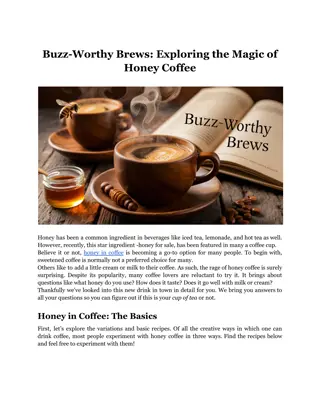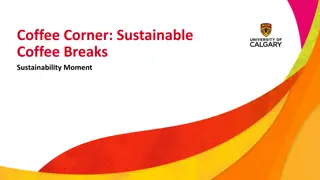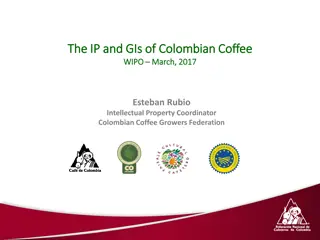Exploring Technological Parameters and Health Effects of Coffee Consumption
The study by Prof. Carla Severini and team delves into the impact of technological parameters on the quality of coffee, as well as the qualitative and healthy aspects associated with coffee consumption. It discusses consumer preferences, the health benefits of coffee, and the complexities of preparing a good cup of coffee. Additionally, it explores the coffee supply chain, variables affecting coffee quality, and various coffee preparation methods.
Download Presentation

Please find below an Image/Link to download the presentation.
The content on the website is provided AS IS for your information and personal use only. It may not be sold, licensed, or shared on other websites without obtaining consent from the author. Download presentation by click this link. If you encounter any issues during the download, it is possible that the publisher has removed the file from their server.
E N D
Presentation Transcript
The quality of coffee as affected by technological parameters. Qualitative and healthy aspects Prof. Carla Severini*, Antonio Derossi, Ilde Ricci, Rossella Caporizzi, Anna Fiore Department of Science of Agriculture, Food and Environment (SAFE) University of Foggia Italy BIT's 6th Annual World Congress of Food and Nutrition-Shenyang Carla Severini (University of Foggia, Italy) 15-17/09/17
80-90% on adults are regular consumers of coffee The consumer s preferences are affected by what? Culture and Tradition Lifestyle Social behaviour Habits Economic aspects Age Healthy effects BIT's 6th Annual World Congress of Food and Nutrition-Shenyang- Carla Severini (University of Foggia, Italy) 15-17/09/17
Coffee and health A growing literature appears to be concluding that coffee consumption may be associated with a reduced risk of type 2 diabetes, coronary heart disease, Alzheimer s disease, Parkinson s disease and even some cancers (hepatocellular and colorectal carcinoma) (Coughlin & Nehlig, 2012) Main effects - Strong antioxidant activity and inhibition of lipid peroxidation (Napolitano et al., 2007; Fogliano et al., 2015). - Significant increase of plasma glutathione concentration due to the concentration of diterpenes (cafesterol), polyphenols and melanoidins, affected by type and origin of ground coffee, roasting degree and brewing procedure (Esposito et al., 2003) Coffee Paradox
However, from a technological point of view . it s not so easy to make a good coffee!
Coffee Supply Chain Production phase Agricultural phase Physical, chemical and sensorial modifications Additional processing phase Including storage Green beans Roasted coffee Preparation methods (Salomone R., 2003)
Variables Coffee varieties and blends of coffee Light, medium, dark R&G conditions Coarse, fine-coarse, fine Espresso, Turkish, American, Moka, Neapolitan, French press coffee, Instant, Espresso single-dose pod or capsule, American single-dose, Cold brew Storage conditions Preparation method (Lerici et al., 1987; Andueza et al., 2003; Romani et al., 2004; Severini et al., 2012, 2014)
R&G Conditions Espresso coffee Fiore et al., 2016 Ricci et al., 2016 BIT's 6th Annual World Congress of Food and Nutrition-Shenyang- Carla Severini (University of Foggia, Italy) 15-17/09/17
0.97 0.96 1 0.96 0.9 0.8 0.7 0.64 0.63 Explained part (R adj.) 0.6 0.55 0.54 0.5 0.4 0.3 0.2 0.1 0 Variables Explained part (R adj) of different model fits describing the effects of grinding grade, weight and pressure on the change in volume of espresso coffee.
Physicochemical parameters of espresso coffee samples (mean values standard deviation) Volume of brew* Titratable acidity* Total solids* Caffeine* Grinding grade Sample pH* (mL NaOH/mL EC) (mL) (mg/mL) (mg/mL) 16.24 3.58 c 5.18 0.02 a 0.33 0.06 a 74.61 0.01 a 4.98 0.62 a 6 PT1 28.86 2.32 b 5.24 0.05 a 0.27 0.01 a 69.70 0.01 a 4.36 0.92 a 6.5 41.85 1.70 a 5.23 0.03 a 0.12 0.01 b 34.63 0.00 b 2.43 0.34 b 7 14.66 2.01 c 5.47 0.07 c 0.06 0.01 a 17.06 0.00 a 1.29 0.25 a 6 PT2 22.92 3.58 b 6.02 0.13 b 0.02 0.00 b 8.53 0.00 b 0.83 0.23 a 6.5 55.90 1.89 a 6.79 0.16 a 0.003 0.00 b 2.68 0.00 c 0.30 0.023 b 7 14.61 1.11 c 5.89 0.20 c 0.02 0.01 a 9.17 0.00 a 0.64 0.15 a 6 PT3 21.29 2.23 b 6.51 0.16 b 0.003 0.00 b 3.78 0.00 b 0.30 0.11 b 6.5 48.02 1.11 a 7.21 0.06 a 4.98 0.42 a 1.08 0.00 b 50.64 7.35 a 0.18 0.01 b 4.18 0.21 a 7 - 0.25 0.01 a 6 25 Regular coffee 5.18 0.02 a 0.24 0.01 a 55.11 4.75 a 4.01 0.16 a 6.5 25 5.16 0.02 a 0.18 0.01 b 44.34 0.74 a 3.21 0.27 b 7 25 (Severini et al., 2015)
60 140 volume 119.75 mg 120 50 caffeine in cup Caffeine in cup (mg) 100 40 Volume (mL) 80 78.94 mg 30 25 mL 60 20 40 10 20 0 0 6 8 10 12 14 16 18 20 22 24 26 28 30 Time (s) Influence of inside variability in grinding grade 6 on caffeine content in cup (Severini et al., )
The variability of particle size distribution of coffee grounds significantly affects the percolation rate, caffeine content, solid content, pH and acidity as a consequence of changes in the microstructural properties of the coffee cake, such as porosity and the percolation pathway. Improvement of performances of grinder devices!! BIT's 6th Annual World Congress of Food and Nutrition-Shenyang- Carla Severini (University of Foggia, Italy) 15-17/09/17
Preparation methods Each technique applies different: water/ground coffee ratios water temperature extraction time and rate water pressures final volume of beverage
Traditional methods Espresso Turkish (Greece, Turkey) Instant Moka (Italy) American French BIT's 6th Annual World Congress of Food and Nutrition-Shenyang- Carla Severini (University of Foggia, Italy) 15-17/09/17
New methods Espresso Single-dose American Single-dose Cold brew BIT's 6th Annual World Congress of Food and Nutrition-Shenyang- Carla Severini (University of Foggia, Italy) 15-17/09/17
Different preparation techniques involve different content of extracted polyphenols, caffeine, total solids. Also, antioxidant activity and volatile profile of extract that greatly vary among different brewing methods (Nicoli et al., 1987; Severini et al., 1988; 1994; 1997; 1999; Illy E., 2002;L pez- Galilea et al., 2007; Severini et al., 2014; 2015; 2017). BIT's 6th Annual World Congress of Food and Nutrition-Shenyang- Carla Severini (University of Foggia, Italy) 15-17/09/17
A commercial blendof Arabica and Robusta (Lo pez-Galilea et al., 2007) mg of caffeine per mL of beverageand total content 0.22 400 mL Filter (American) 88 mg Plunger (French) 0.20 500 mL 100 mg Mocha (Italian) 0.28 500 mL 140 mg Espresso (Italian) 0.63 40 mL 25 mg In cup BIT's 6th Annual World Congress of Food and Nutrition-Shenyang- Carla Severini (University of Foggia, Italy) 15-17/09/17
For instance Relationship among caffeine content, total phenol content and antioxidant activity and different brewing procedures E-FC =Espresso fine-coarse Caffeine 1200 A a AB a E B a Total phenol content (GAE) Antiox. Activity (Trolox) 1000 A a A-FC= American fine-coarse A a 800 B a mg/Cup A b A b A b B b 600 B c B b T-FC= Turkish fine-coarse A a B a A b A b B a 400 A b A b A b A b A b A b A b 200 B c B c A c 0 E-F E-FC E-C A-F Coffee beverages A-FC A-C T-F T-FC T-C Derossi et al, 2017 BIT's 6th Annual World Congress of Food and Nutrition-Shenyang- Carla Severini (University of Foggia, Italy) 15-17/09/17
mg/mL BIT's 6th Annual World Congress of Food and Nutrition-Shenyang- Carla Severini (University of Foggia, Italy) 15-17/09/17
After extraction From semi-exhausted cake we can obtain: - Antioxidants - Caffeine - Energy (https://www.comunicaffe.it/fondi-di-caffe-berna-metano/) The exhausted coffee could be still used as material for objects (design), fertilizer, cosmetics, etc. BIT's 6th Annual World Congress of Food and Nutrition-Shenyang- Carla Severini (University of Foggia, Italy) 15-17/09/17
Industrial recycling of exhausted coffee powder Designer: Matthijs Vogels, Eindhoven, Holland
Domestic recycling Odor absorbing Ash binder Ant and snail repellent Compost Soil fertilizer Mushroom crop Rust preventer Body scrub Natural color
Antioxidant capacity of spent ground coffee ? Variables? 25 C? 40 C? Antioxidant? capacity? ( moli? Trolox/g)? 52.98 4.76? 74.76 2.67? Phenolic? content? (mg? GAE/g)? 13.15 0.140? 18.47 0.083? As known, green tea is commonly considered a brew very rich in antioxidants. Baucirova (2010), studying 15 types of tea, reported a mean value of 1.43 moli Trolox/mL stating as, the spent espresso coffee ground has an antioxidant capacity ranged between 37.05 and 54.35 times those of green tea. (Severini et al., 2016)
The great environment cost of single-dose coffee The capsules are classified as not recyclable by EU regulations, so they cannot be selected or send to shared collection (one of the most present waste in not shared waste more than 70% of the total). Private Company project for capsule internal recycling (Nespresso)
WHY SINGLE DOSE COFFEE? More convenient Less expensive for consumers? (specific devices, price per single dose) More standardized (!!) Same quality? BIT's 6th Annual World Congress of Food and Nutrition-Shenyang- Carla Severini (University of Foggia, Italy) 15-17/09/17
The characteristics of coffee in capsules could be very different Derossi et al., ASIC 2016 BIT's 6th Annual World Congress of Food and Nutrition-Shenyang- Carla Severini (University of Foggia, Italy) 15-17/09/17
Conclusions A GOOD COFFEE DEPENDS ON A NUMBER OF VARIABLES HOWEVER THE TECHNOLOGICAL VARIABLES SEEM TO BE MORE IMPORTANT THAN AGRONOMICAL ONES THUS BIT's 6th Annual World Congress of Food and Nutrition-Shenyang- Carla Severini (University of Foggia, Italy) 15-17/09/17
NOT ONLY ARABICA 100%........ BUT STRONG THECHNOLOGICAL KNOWLEDGE AND SKILLS COULD LEAD TO A HIGH QUALITY COFFEE THANK YOU FOR YOUR ATTENTION BIT's 6th Annual World Congress of Food and Nutrition-Shenyang- Carla Severini (University of Foggia, Italy) 15-17/09/17
References CoughlinJR, NehligA. Coffee and cancer: A benefit-riskevaluationof the experimentaland epidemiologicalevidence. In: The 24th International Conference on Coffee Sciences (ASIC 2012)-12-16 November, San Jose , Costa Rica. ASIC Pub. - Wa denswil(Switzerland) pp. 25-32 1. 2. Esposito F, MoriscoF, Verde V, Ritieni A, Alezio A, CaporasoN, FoglianoV. Moderate coffee consumptionincreasesplasma glutathionebut not homocysteinein healthy subjects. AlimentPharmacolTher. 2003 Feb 15;17(4):595-601. 3. 4. Salomone R. Life cycle assessment applied to coffee production: Investigating environmental impacts to aid decision making for improvements at company level. Food, Agriculture & Environment Vol.1(2) : 295-300. 2003 5. LERICI C.R, DALLA ROSA M, NICOLI M.C, SEVERINI C. Influences of Processing Conditions on the Properties of Coffee Beverage . In: Trends in Food Processing II. Singapore, 1987, SINGAPORE: Ang How Ghee, Inst. of Food Sci. and Technol., p. 94-98 6. Andueza S, de Pen a, MP and Cid C, Chemical and sensorial characteris- tics of espresso coffee as affected by grinding and torrefacto roast. J Agric Food Chem 51:7034 7039 (2003). 7. Romani S, Severini C, Fiore AG and Pinnavaia GG. Quality of espresso coffee: A study performed through Italian coffee shops. In: International Scientific Colloquium on Coffee: Proceedings (20th ASIC); 11-15 October 2004; Bangalore, India 8. Severini C, Romani S, Cevoli C and Derossi A, Quality in cup of espresso coffee: data from over ten years of investigation, in International Conference on Coffee Science: Proceedings (24th edn), San Jose , Costa Rica, pp. 201 208 (2012). 9. 10. Illy E, The complexity of coffee. Sci Am 6:92 98 (2002). 11. Severini C, Derossi A, De Pilli T , Del Mastro A and Alessandrino O, Modelling espresso coffee preparation, in International Conference of Coffee Science: Proceedings (25th edn), Armenia, Colombia, pp. 8 13 (2014). 12. FIORE, A., G., DEROSSI, A., RICCI, I., CAPORIZZI, R., SEVERINI, C. 2016. Influence of grinding grade on the quality of espresso obtained from different roasted coffee . 26th International Conference on Coffee Science (ASIC). Kunming (Yunnan, China). 13.
Severini, C., Ricci I.,, Marone M., Derossi, A., De Pilli. T. 2015. Changes in the aromatic profile of espresso coffee as a function of the grinding grade and extraction time: a study by electronic nose system . Journal Agricultural Food Chemistry, 4, 63, 2321-2327. 14. Nicoli MC, Dalla Rosa M, Lerici CR, Severini C. Caratteristiche chimiche dell estratto di caffe . Nota 1: Cinetiche di estrazione della caffeina e delle sostanze solide. Industrie Alimentari. 1987;26:467-471 15. Severini C, Romani S, Pinnavaia GG. Indagine sulla qualita del caffe espresso. Industrie Alimentari. 1997;36:12-16 16. Severini C, Mastrocola D., Nicoli M. C, Dalla Rosa M. (1988). "Caratteristiche chimiche dell'estratto di caffe . Nota 2. Cinetica di estrazione delle sostanze volatili". Industrie Alimentari, 261, 537-540 17. Severini C, Giuliani S and Pinnavaia GG, Studio sui diversi sistemi di estrazione della bevanda di caffe . Ind Bevande 23:227 230 (1994). 18. Severini C., De Pilli T., Romani S., Pinnavaia G.G. 1999. Studio sulle caratteristiche qualitative del caffe espresso all italiana attraverso una indagine negli esercizi di vendita . Industrie Alimentari, vol. 38, p. 1279-1284, ISSN: 0019-901X 19. L pez-Galilea I,dePen a MP,Cid C. Correlationofselectedconstituentswiththetotal antioxidant capacity of coffee beverages: Influence of the brewing procedure. Journal of Agricultural and Food Chemistry. 2007;55:6110-6117. DOI: 10.1021/jf070779x 20. SEVERINI, C., DEROSSI, A., DE PILLI T., DEL MASTRO, A., ALESSANDRINO, O. Modelling Espresso Coffee Preparation . In Proceedings of 25th International Conference on Coffee Science (ASIC), 8-13 settembre 2014, Armenia, Colombia. (CD rom), p. 42-50. 21. Severini C, Derossi A, Fiore AG, De Pilli T, Alessandrino O, Del Mastro A (2015) How the variance of some extraction variables may affect the quality of espresso coffees served at coffee shop? J Sci Food Agric. doi:10.1002/jsfa.7472 22. Severini C., Derossi A., Ricci I., Fiore A.G., Caporizzi R., 2017. How Much Caffeine in Coffee Cup? Effects of Processing Operations, Extraction Methods and Variables. Agricultural and Biological Sciences "The Question of Caffeine", book edited by Jolanta Natalia Latosinska and Magdalena Latosinska, ISBN 978-953-51-3274-5, Print ISBN 978-953-51-3273-8, Published: June 21, 2017 under CC BY 3.0 license. DOI: 10.5772/intechopen.69002 23. Derossi A., Ricci I., Caporizzi R., Fiore A.G., Severini C. 2017 How grinding levels and brewing methods (Espresso, American, Turkish) could affect the antioxidant activity and bioactive compounds in a coffee cup. Submitted 24. Severini C, Derossi A, Fiore AG, De Pilli T, Alessandrino O, Del Mastro A. How the variance of some extraction variables may affect the quality of espresso coffees served at coffee shop? Journal of the Science of Food and Agriculture. 2016;96:3023-3031. DOI: 10.1002/jsfa.7472 25. Derossi A, Severini C, Ricci I, Fiore AG, Caporizzi R. Espresso coffee from the single- dose capsule system. A comparison among different brands based on macroscopic and microscopic properties. Poster n.431 in The 26th International Conference on Coffee Sciences (ASIC 16); 13-20 November 2016; Kunming. Yunnan China ASIC Pub. - Wa denswil (Switzerland), 2016 26. BIT's 6th Annual World Congress of Food and Nutrition-Shenyang- Carla Severini (University of Foggia, Italy) 15-17/09/17























